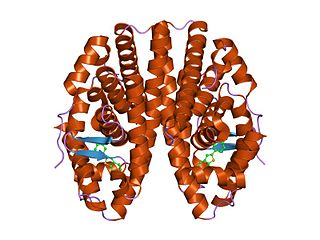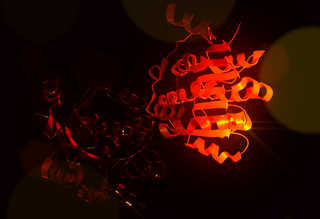
Retroviral integrase (IN) is an enzyme produced by a retrovirus that integrates its genetic information into that of the host cell it infects. Retroviral INs are not to be confused with phage integrases (recombinases) used in biotechnology, such as λ phage integrase, as discussed in site-specific recombination.

P300/CBP-associated factor (PCAF), also known as K(lysine) acetyltransferase 2B (KAT2B), is a human gene and transcriptional coactivator associated with p53.

The nuclear receptor coactivator 2 also known as NCoA-2 is a protein that in humans is encoded by the NCOA2 gene. NCoA-2 is also frequently called glucocorticoid receptor-interacting protein 1 (GRIP1), steroid receptor coactivator-2 (SRC-2), or transcriptional mediators/intermediary factor 2 (TIF2).

Nuclear respiratory factor 1, also known as Nrf1, Nrf-1, NRF1 and NRF-1, encodes a protein that homodimerizes and functions as a transcription factor which activates the expression of some key metabolic genes regulating cellular growth and nuclear genes required for respiration, heme biosynthesis, and mitochondrial DNA transcription and replication. The protein has also been associated with the regulation of neurite outgrowth. Alternate transcriptional splice variants, which encode the same protein, have been characterized. Additional variants encoding different protein isoforms have been described but they have not been fully characterized. Confusion has occurred in bibliographic databases due to the shared symbol of NRF1 for this gene and for "nuclear factor -like 1" which has an official symbol of NFE2L1.

Nuclear transcription factor Y subunit beta is a protein that in humans is encoded by the NFYB gene.

SWI/SNF-related matrix-associated actin-dependent regulator of chromatin subfamily B member 1 is a protein that in humans is encoded by the SMARCB1 gene.

TAF9 RNA polymerase II, TATA box binding protein (TBP)-associated factor, 32kDa, also known as TAF9, is a protein that in humans is encoded by the TAF9 gene.

Probable ATP-dependent RNA helicase DDX5 also known as DEAD box protein 5 or RNA helicase p68 is an enzyme that in humans is encoded by the DDX5 gene.

General transcription factor IIH subunit 4 is a protein that in humans is encoded by the GTF2H4 gene.

Barrier-to-autointegration factor is a protein that in humans is encoded by the BANF1 gene. It is a member of the barrier-to-autointegration factor family of proteins.

Transcription initiation factor TFIID subunit 12 is a protein that in humans is encoded by the TAF12 gene.

Transcription initiation factor TFIID subunit 4 is a protein that in humans is encoded by the TAF4 gene.

Nuclear receptor coactivator 6 is a protein that in humans is encoded by the NCOA6 gene.

Transcription initiation factor TFIID subunit 2 is a protein that in humans is encoded by the TAF2 gene.

Transcription initiation factor TFIID subunit 5 is a protein that in humans is encoded by the TAF5 gene.

Necdin is a protein that in humans is encoded by the NDN gene.

TAF5-like RNA polymerase II p300/CBP-associated factor-associated factor 65 kDa subunit 5L is an enzyme that in humans is encoded by the TAF5L gene.

Cell division cycle-associated 7-like protein is a protein that in humans is encoded by the CDCA7L gene.

Hepatoma-derived growth factor, related protein 3, also known as HDGFRP3, is a human gene.

AIDS is caused by the human immunodeficiency virus (HIV). Individuals with HIV have what is referred to as a "HIV infection". When infected semen, vaginal secretions, or blood come in contact with the mucous membranes or broken skin of an uninfected person, HIV may be transferred to the uninfected person, causing another infection. Additionally, HIV can also be passed from infected pregnant women to their uninfected baby during pregnancy and/or delivery, or via breastfeeding. As a result of HIV infection, a portion of these individuals will progress and go on to develop clinically significant AIDS.




























